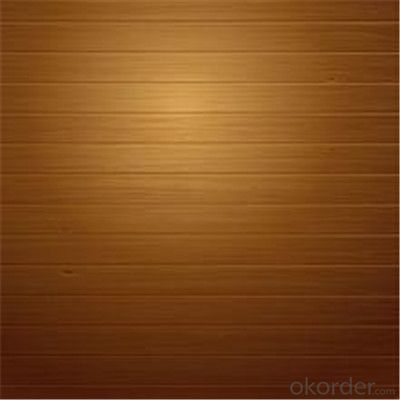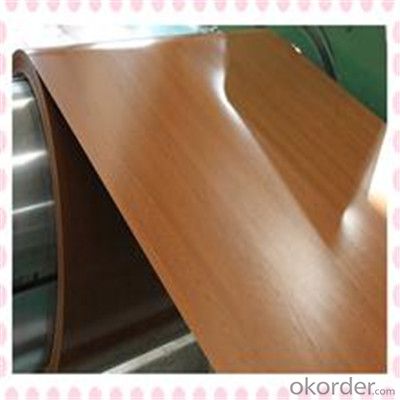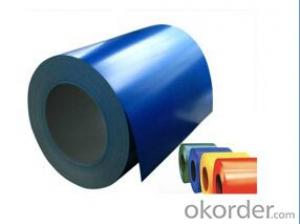Wood Pattern Printed Galvanized PPGI Steel Sheet
- Loading Port:
- Qingdao
- Payment Terms:
- TT OR LC
- Min Order Qty:
- 20 m.t.
- Supply Capability:
- 1200000 m.t./month
OKorder Service Pledge
OKorder Financial Service
You Might Also Like
Specification
Description of Glove:
Grade : SGCD,SGCH, Q195,DX51D
Galvanized steel sheet /coil features:
1. Zinc coating :40-180g( as required)
2. thickness:0.2-1.2mm
3. width:914-1250mm(914mm, 1215mm,1250mm,1000mm the most common)
4. coil id:508mm/610mm
5. coil weight: 4-10 MT(as required)
6. surface: regular/mini/zero spangle, chromated, skin pass, dry etc.
Festures of Glove:
Base Metal Thickness | 0.2mm – 1.2mm |
Width | 800mm – 1600mm |
Coil Internal Diameter | 508 mm - 610 mm |
Coil Weight | MAX 8 M.T |
Metallic coating | Z60 – Z275g AZM 60-AZM275 g |
Thickness of organic coating | 15micro – 25micro (as customers’ requirement) |
Specifications of Glove:
1) Excellent corrosion resistance: The zinc layer provides a good protection of Pre-painted Galvanizeed Steel Sheet.
2) High heat resistance: The reflective surface of the material aids in efficiently reflecting the sunlight away and in turn reducing the amount of heat transmitted. The thermal reflectivity converts into energy savings.
Images of Glove:

FAQ:
1.What about the delivery.
We can arrange the shipment about 15-25 days after the deposit.
2.What about payment term?
30% T/T deposit, balance against B/L copy.
Full T/T payment if quantity less than MOQ.
3.How much about MOQ?
Normally 100pcs,but small order is acceptable as well.
- Q: I work the Copper plating line at a custom plating facility in MI.I like to use jumper cables with the jumper cable clamps to help confirm electric current is getting to my parts that I am plating. The acids in the Acid copper is constantly eating the steel and copper clamps. WIll I get a good enough current through stainless steel clamps? I use stainless steel hooks, but our maintenance man thinks that is one of the reasons why I have prblems with my parts turning out. I still think it has to do with the clamps getting eatin up. My question is Is stainless steel as good or reliable enough to run an electrical current to my parts if I am using stainless steel or is it best to use another method to try and get a better connection.Please state your sources or experience with working with electricity. I need to get honest answers and not this is my opinion. We are talking about my making a living so this is important to me so I can bring food home to my table. Thanks for all the help.
- I can only guess. I can't even tell if you are plating some other metal with copper OR if you are plating copper with some other metal. you state that you use the copper clamps only to confirm the current, but I don't see how that works. I suspect that the plating current actually goes through these clamps, so conductivity is very important. But, the conductivity of SS is about 1/5th that of copper, so that will definitely have an effect, and not a good one. .
- Q: What is the average width tolerance for steel coils?
- The average width tolerance for steel coils can vary depending on the specific industry and application. However, in general, the standard width tolerance for steel coils is typically around ±0.005 to ±0.020 inches.
- Q: How are steel coils used in the manufacturing of automotive accessories?
- Steel coils are used in the manufacturing of automotive accessories as they are processed and shaped into various components such as brackets, frames, and supports. These coils are typically cut, molded, and stamped into specific shapes before being assembled into the final product, adding strength and durability to the accessories.
- Q: which is the most tough and durable steel type ??
- Speaking of Building Construction, we use grade 450 and 450B not because of toughness, its because it best serves its purpose, reinforcing concrete structure should provide the enough ductility of structure to resist flexure/bending when loads are imposed on it.
- Q: What are common uses for steel coils?
- Steel coils are commonly used in various industries for purposes such as manufacturing automobiles, appliances, construction materials, and metal fabrication. They are also used in the production of pipes, tubes, and structural components, making them a versatile material for a wide range of applications.
- Q: What are the dimensions of steel coils used in the oil and gas industry?
- The dimensions of steel coils used in the oil and gas industry can vary depending on the specific application and requirements. However, there are some common dimensions that are frequently used. Steel coils used in the oil and gas industry typically have a width ranging from 600mm to 2000mm. The outer diameter of the coil can range from 800mm to 2200mm, while the inner diameter can range from 508mm to 610mm. The weight of the coil can vary as well, ranging from a few tons to several tens of tons. These dimensions are designed to meet the needs of various processes involved in the oil and gas industry, such as pipe manufacturing, storage tank fabrication, and offshore platform construction. It is important to note that these dimensions are not fixed and can be customized based on the specific requirements of each project.
- Q: What are the common welding methods used for steel coils?
- There are several common welding methods used for steel coils, depending on the specific requirements and applications. Some of the most widely used methods include: 1. Shielded Metal Arc Welding (SMAW): Also known as stick welding, SMAW uses an electrode coated in flux to create an arc between the electrode and the base metal. This method is commonly used for its simplicity and versatility, making it suitable for a wide range of steel coil welding applications. 2. Gas Metal Arc Welding (GMAW): Also known as MIG (Metal Inert Gas) welding, GMAW uses a continuous wire electrode and a shielding gas to protect the weld pool from atmospheric contamination. This method is favored for its high welding speed and excellent control over the welding process. 3. Flux-Cored Arc Welding (FCAW): Similar to GMAW, FCAW uses a continuously fed tubular electrode filled with flux to protect the weld pool. This method is often preferred for its high deposition rates and ability to weld thicker steel coils, making it ideal for heavy-duty applications. 4. Gas Tungsten Arc Welding (GTAW): Also known as TIG (Tungsten Inert Gas) welding, GTAW uses a non-consumable tungsten electrode and an inert gas shield to protect the weld pool. This method is commonly used for its precise control, high-quality welds, and ability to weld thin materials. 5. Submerged Arc Welding (SAW): SAW involves the formation of an arc between a continuously fed wire electrode and the steel coil, while a granular flux covers the arc and weld area. This method is frequently used for its high productivity and ability to weld thick materials. Each of these welding methods has its own advantages and limitations, and the choice of method depends on factors such as the thickness of the steel coil, desired welding speed, weld quality, and application requirements.
- Q: I have a set of steel pans with copper bottoms. When I cook with oil it always burns the oil to the pan and takes days to clean. I don't think I should use steel wool, since it might scratch the surface. Does anyone know a faster way to clean scorched oil off a steel pan?
- they have drywall (mudding) sponges to sand mud when you fix walls in the house, they are grey, square, and do not scratch. They seem to work better than any scrubber ever. Make sure you use a degreaser dishsoap like dawn. Maybe try putting your heat lower in the pan and cooking things more slowly?
- Q: How are steel coils used in the automotive stamping process?
- Steel coils are essential for the automotive stamping process, serving as a crucial element. These coils are large rolls of steel, which are unwound and fed into stamping machines. They are typically made of high-quality steel and come in different thicknesses and widths to meet specific requirements for automotive parts. In the stamping process, the steel coils pass through a series of dies and presses that shape and form the metal into desired automotive components. To ensure a smooth and consistent feed into the stamping machine, the coils are unwound and straightened to remove any bends or twists. The stamping machine applies hydraulic or mechanical force to press the steel coil against a specially designed mold called a die. The die, often made of hardened steel, can withstand the pressure and provide accurate and repeatable results. At high speed, the steel coil is fed into the stamping machine, and as it passes through the die, the metal takes shape as various automotive parts such as body panels, doors, hoods, fenders, and structural components. The stamping process offers high precision and consistency, meeting required specifications and tolerances. After forming, the metal may undergo additional processes like trimming, piercing, or bending to achieve the final shape. These processes can be carried out in subsequent stamping stations or by using progressive dies that combine multiple operations into a single pass. Overall, steel coils are vital in the automotive stamping process, providing the necessary raw material to produce various components. The use of steel ensures strength, durability, and safety of automotive parts while maintaining cost-effectiveness and mass production capabilities.
- Q: How are steel coils used in the agricultural sector?
- Various purposes in the agricultural sector call for the widespread use of steel coils. One primary utilization is seen in the construction of farm machinery and equipment. Tractors, plows, harvesters, and other heavy-duty machinery are frequently manufactured using steel coils. The exceptional strength and durability of steel make it an ideal material for such applications, as it can endure the challenging conditions of agricultural work. Furthermore, agricultural buildings and structures heavily rely on steel coils in their construction. Steel is renowned for its superior structural integrity, making it a popular choice for barns, storage units, and other agricultural facilities. Steel coils are frequently employed to establish the framework and support systems of these structures, providing stability and long-lasting durability. Moreover, irrigation systems also rely on steel coils in their production. Steel coils are often used to create the pipes and tubes used for water transportation in agricultural irrigation systems. Steel's resistance to corrosion and its ability to handle high-pressure flows make it an excellent choice for this particular application. To summarize, steel coils hold a critical role in the agricultural sector. Whether it be the construction of farm machinery and buildings or the development of irrigation systems, steel's strength and durability make it the preferred material in this industry.
Send your message to us
Wood Pattern Printed Galvanized PPGI Steel Sheet
- Loading Port:
- Qingdao
- Payment Terms:
- TT OR LC
- Min Order Qty:
- 20 m.t.
- Supply Capability:
- 1200000 m.t./month
OKorder Service Pledge
OKorder Financial Service
Similar products
Hot products
Hot Searches
Related keywords



























